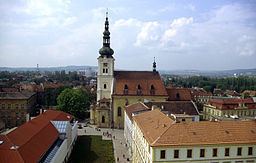- summer (DST) CEST (UTC+2) Local time Wednesday 1:14 PM | Area 50.4 km² | |
 | ||
Weather 14°C, Wind NW at 14 km/h, 66% Humidity Neighborhoods Dědice, Lhota, Opatovice, Zouvalka, Nosálovice, Brňany Points of interest Vyškov Zoo, DinoPark Vyškov, Hvězdárna Vyškov, Muzeum Vyškovska - příspěvko, Zámecká zahrada | ||
Vyškov ( [ˈvɪʃkof]; German: Wischau) is a town in the South Moravian Region of the Czech Republic, with a population of around 22,300 inhabitants.
Contents
- Map of 682 01 Vyskov Czechia
- Vy kov z v ky
- German speaking Wischau
- Modern Vykov
- Famous people from Vykov
- Wischau in literature
- Twin towns
- References
Map of 682 01 Vyskov, Czechia
Vy kov z v ky
German-speaking Wischau
By the middle of the 14th century, pest epidemics and starvation had virtually depopulated the entire area. The Catholic Church, the owners of the lands, administrated their properties via its cloisters in Bamberg, Augsburg and Brixen. These cloisters called upon German farmers to resettle the area. At that time the German-speaking area comprised about 60 villages, only eight of which, with a population of around 3500, still existed by the time of the expulsion of the Germans after World War II.
The inhabitants were mostly farmers. Their lives consisted mainly of hard work. The population was Roman Catholic, and the rhythm of life was therefore mainly governed by the church and its festivities. An education in a German school was considered to be of great importance; six villages had their own German elementary school and the town of Lissowitz had a grammar school. As a result of the geographic separation from other German settlements, the language of these German-speaking inhabitants retained its original form to a great extent, and the area became a language island. It is a variety of a Southern German dialect. One peculiarity is that a "w" was pronounced very much like a "b."
After their expulsion, the former inhabitants of the area went to Germany, Austria and other countries. In 1949 an association, "Language Island of Wischau", was formed in the German town of Aalen to help the scattered families move together again.
Modern Vyškov
The Vyškov Zoo opened in 1965. In 2006, a new Dinopark was opened, located about 2.5 kilometres (1.6 miles) outside the city in the former "Marchanice" park. There are currently around 30 life-size dinosaur models in the park, and it is one of the most visited attractions in the area.
Vyškov has a top-level rugby team, RC Vyškov, who play in the KB Extraliga and have been national champions 11 times.
Famous people from Vyškov
Wischau in literature
The town is mentioned in War and Peace, by Leo Tolstoy, in Book 3 Chapters 10 and 11.
Krambambuli, by Marie von Ebner-Eschenbach, a short story part of Dorf- und Schloßgeschichten (Village and castle stories), is also set in the town.
Twin towns
Vyškov is twinned with:
